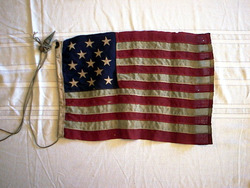

Obverse
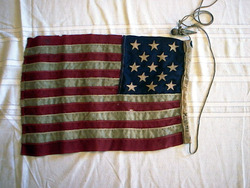
Reverse
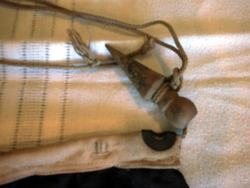
Attachment
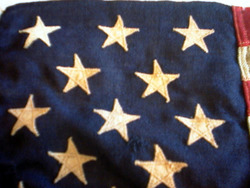
Obverse Stars
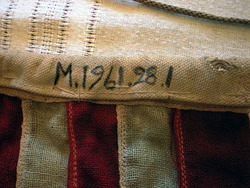
Reverse Detail
U.S. 13-Star Flag, Nathaniel Hall.
Sub-collection: Star Spangled Banner Flag HouseU.S. 13-Star Flag, Nathaniel Hall.
U.S. 13-Star Flag, Nathaniel Hall.
This flag belonged to Mary Nettie Holland (nee Hall), granddaughter of Nathaniel Hall, a veteran of the War of 1812. Circa early 1900s.
After the Declaration of Independence was signed on 4 July 1776, American colonists realized they needed one flag to replace the assortment of flags used previously. Thus, on 14 June 1777, the Continental Congress adopted the following resolution: RESOLVED, that the flag of the 13 United States be thirteen stripes, alternate red and white: That the union be thirteen stars, white in a blue field, representing a new constellation.
Because the resolution was not specific there were a number of variations of the 13-star flag. Legend has it that Betsy Ross sewed the first flag from a design by George Washington, but this has not been substantiated. A strong case can be made that the designer of the first flag was Francis Hopkinson, a delegate from New Jersey to the Continental Congress and a signer of the Declaration of Independence. He submitted a bill to Congress for currency designs, design for the great seal of the U.S., a treasury seal, a design for the flag ...
Among the first documented U.S. flags was the staggered star pattern of 3-2-3-2-3 that you see on this flag. Star patterns like this would remain in use, both among the general public and the U.S. Navy until 1912.
This flag belonged to Mary Nettie Holland (nee Hall), granddaughter of Nathaniel Hall, a veteran of the War of 1812 and dates from the Centennial Era.
Exhibition History
Chicago Meeting December, 2003
Provenance:
• Nathaniel Hall & family, used in 1876.
• By descent in Hall family.
• Mrs. Mary Nettie Holland (nee Hall), to daughters.
• Mrs. Gertrude Rolker & Mrs. Virginia Becker, until 1961.
• Gifted to the Star Spangled Banner Flag House & Museum, until 1996.
• Acquired by the Zaricor Flag Collection from the Star-Spangled Banner Flag House Collection of Baltimore, MD. in 1996.
ZFC Important Flag
Item is Framed
Hoist & Fly | |
|---|---|
| Width of Hoist | 17.5 |
| Length of Fly | 12 |
Union/Canton | |
|---|---|
| Width of Union/Canton | 6.75 |
| Length of Union/Canton | 6.5 |
Stars | |
|---|---|
| Size of Stars | 1.25 |
Stripes | |
|---|---|
| Width of 1st Stripe | 1 |
| Width of 3rd Stripe | 1 |
| Width of 8th Stripe | 0.75 |
| Width of Last Stripe | 1.25 |
| Size of Hoist | 0.75 |
Frame | |
|---|---|
| Is it framed? | yes |
| Frame Height | 17 |
| Frame Length | 24 |
Stars | |
|---|---|
| Number of Stars | 13 |
| How are the stars embeded? | Sewn |
| Are there stars on obverse? | yes |
| Are there stars on reverse? | yes |
Stripes | |
|---|---|
| Number of Stripes | 13 |
| Color of Top Stripe | Red |
| Color of Bottom Stripe | Red |
| Has a Blood Stripe? | no |
Fabric | |
|---|---|
| Fabric | Wool |
| Comments on Fabric | Bunting |
Stitching | |
|---|---|
| Stitching | Machine |
| Comments on Stitching | Hoist hand stitched |
Thread | |
|---|---|
| Thread Material | Cotton |
Attachment | |
|---|---|
| Comments on Method of Attachmen | Sleeve with rope |
Documentation | |
|---|---|
| Documents | |
| Drawings |
All original documents and drawings are held in the Zaricor Flag Collection Archives.
|
| Research Documents | |
| Public Copy & Signs | |
Condition | |
|---|---|
| Condition | Good |
| Damage | White Discolored to yellow Small stains Damaged by moths |
| Displayable | yes |
Exhibits | |
|---|---|
| Exhibition Copy | Exhibition History Chicago Meeting December, 2003 (ZFC0074) 13-Star United States Flag Date: Circa early 1900s Media: Sewn wool bunting with cotton stars Comment: After the Declaration of Independence was signed on 4 July 1776, American colonists realized they needed one flag to replace the assortment of flags used previously. Thus, on 14 June 1777, the Continental Congress adopted the following resolution: RESOLVED, that the flag of the 13 United States be thirteen stripes, alternate red and white: That the union be thirteen stars, white in a blue field, representing a new constellation. Because the resolution was not specific there were a number of variations of the 13-star flag. Legend has it that Betsy Ross sewed the first flag from a design by George Washington, but this has not been substantiated. A strong case can be made that the designer of the first flag was Francis Hopkinson, a delegate from New Jersey to the Continental Congress and a signer of the Declaration of Independence. He submitted a bill to Congress for currency designs, design for the great seal of the U.S., a treasury seal, a design for the flag ... Among the first documented U.S. flags was the staggered star pattern of 3-2-3-2-3 that you see on this flag. Star patterns like this would remain in use, both among the general public and the U.S. Navy until 1912. Provenance: This flag belonged to Mary Nettie Holland (nee Hall), granddaughter of Nathaniel Hall, a veteran of the War of 1812. It was given to the Star-Spangled Banner Flag House in 1961 and was acquired by the Zaricor Flag Collection (ZFC0074) in 2000. |








